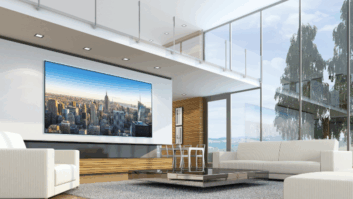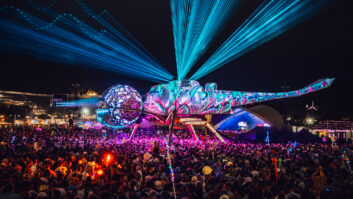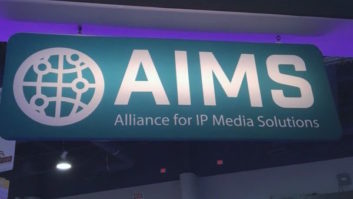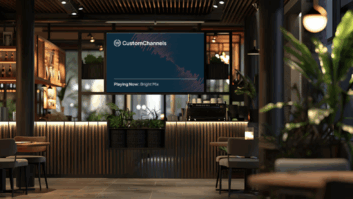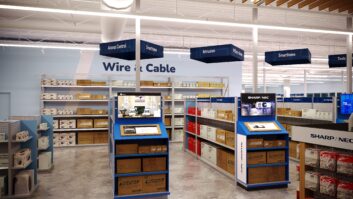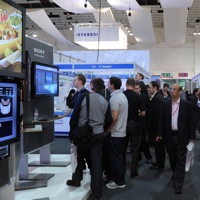
With an increased attendance, big-name exhibitors and a greater emphasis on green issues, Screen Media Expo is growing up alongside the industry that it serves, reports Paddy Baker
It was hard to tell whether this year’s Screen Media Expo – the UK’s main show for the digital signage and DOOH industries – was larger or smaller than last year’s, following its move to London’s Earls Court from nearby Olympia. According to organiser Screen Events, square footage on the showfloor was up by 20%, although it wasn’t made clear if this included non-exhibition space, such as seating areas. However, the number of feet through the door was emphatically higher: the official attendance figure over the two days of the show was 3,195, up 8% on 2009. The proportion of visitors from outside the UK and Ireland was 35%, which was less than last year – probably, according to the organisers, due to volcano-related travel scares.
With 50 accredited press passes issued, Screen Events says that overall coverage of the show has been ‘superb’. There was certainly a favourable report in the business pages of London’s Evening Standard a couple of weeks after the show, commenting on Microsoft’s and Intel’s presence and describing how their technology can be used in interactive DOOH applications that detect the viewer with a billboard-mounted camera and tailor the advertisement to suit their gender or age.
The two computing giants were presenting an embedded technology platform, using Intel chips and Windows software, developed for digital signage applications. Intel’s director of digital signage, Jose Avalos, described this as “the first and currently only platform in the digital signage industry to offer remote manageability with a validated operating system”. Also present on the stand were partners including Harris, whose InfoCaster Player software was used to display content on the stand, and YCD Multimedia, which released version 2.0 of its YCD|RAMP (retail advertising and merchandising platform).
Another big name announcing its entry into the European digital signage market was NCR. Last November NCR acquired Netkey, whose digital signage software runs more than 70,000 digital signs and kiosks in North America. NCR Netkey is available on a licence or on a software-as-a-service basis.
Overall, there seemed to be a stronger focus at this year’s show on solutions that provide quantitative data for advertisers or retailers. AMX, for example, demonstrated its digital signage technology in the form of a retail shelf with different mobile phone models. When you picked up a phone, its details appeared on the screen; pick up another, and you could see a side-by-side feature comparison. That’s obviously useful to the shopper, but it’s also valuable to the retailer who gets a detailed breakdown of which phones were picked up most often.
3D and green
The 3D boom was also evident at this show – although glasses-free was the order of the day. One company demonstrating this technology was Alioscopy, which uses a lenticular display to produce stereoscopic 3D images that sit in front of the screen. The company was also promoting its Alioscopy Meda Player (Mix&Play) software.
While 3D digital advertising is certainly an eye-grabber, its future in advertising is not assured because of the need for special displays and content. Symon Dacon had a lower-cost alternative to genuine stereoscopic 3D in the form of Symon LiveView. This uses optical reflection technology to give an illusion of depth to 2D content.
Following the behind-closed-doors preview of the technology at ISE in February, Prysm’s LPD (laser phosphor display) made its official European show debut at Screen Media Expo. The displays, which have no bezel and a 0.2mm seam, were demonstrated by exclusive UK distributor PSCo in a videowall formation of 25in units. Prysm states that each LPD panel draws 30W of power, making it around seven times more efficient than an average LCD screen.
To drive this point home, Prysm has launched the cleverly named ECO (environmental cost of operation) calculator on its website (www.prysm.com). Users enter details of their current display setup (the size, number and type of screens used), its usage, expected lifetime and energy cost. ECO then calculates the amount of energy, cost and greenhouse emissions that would be saved by switching to LPD technology.
Another environmental development was launched after the show on the first day. Organised by industry body The Screen Forum, the Green Screen initiative sets out 12 sustainable guidelines which it invites companies in the digital advertising business to sign up to. Each was presented by a different sponsor – which included manufacturers such as NEC, Magenta Research, Harris and Digital View, as well as outdoor advertising company CBS Outdoor and software companies such as dZine and Broadsign.
The ‘12 Steps’, as they are called, cover a range of measures including positioning outdoor screens sympathetically, and minimising the power consumption of screens and computers.
Richard Cobbold, CEO of The Screen Forum, said the aim of the initiative is to produce a set of principles that the sector can point to if (or when) it faces an environmental backlash from politicians or the public.
The last word goes to Chris Welch, CEO of Saturn Communications Group. His company has gone from being a content management system provider to a ‘one-stop shop’ for digital signage solutions, offering other companies’ products as well as its own. He said that over his three years attending Screen Media Expo, he had seen it mature – visitors are more knowledgeable, and the leads generated are more targeted than in the past.
And if the show is maturing, so is the industry it serves as it faces up to its wider responsibilities, attracts major corporations and gets favourable reports in the mainstream press. We look forward to next year’s show, which will be held in Earls Court 2 on 18-19 May. In the meantime, speaker slides from the show’s conferences and video clips are available from the show website.


